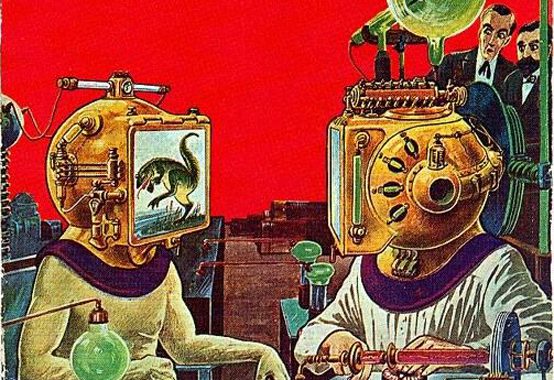Pulp Paranoia

One winter day in 1943 an odd letter arrived at the offices of the sci-fi pulp magazine Amazing Stories. The author, a steelworker named Richard Shaver who had spent some time in mental institutions, claimed to have uncovered “an immensely important find”: the ancient alphabet of a “wiser race” that preceded humanity on Earth. An amused staffer read some entertainingly weird bits of the correspondence out loud, and dropped the document into the trash.
His boss immediately retrieved it. “You call yourself an editor?” he asked.
The man who salvaged and then published the papers was Ray Palmer, the Milwaukee-bred subject of Fred Nadis’s new biography The Man From Mars. Palmer’s editorial instincts turned out to be sound: Shaver’s letter may have been ludicrous, but it inspired a lot of reader interest. And it made Shaver a part of the Amazing Stories stable, an association that proved very profitable for Palmer’s magazine.
Shaver followed up with a 10,000-word manuscript he called “A Warning to Future Man,” a purportedly true account of the ancient beings who lived beneath the ground. Palmer rewrote this into a 30,000-word story called “I Remember Lemuria,” and started promoting it heavily. “For the first time in its history,” he wrote in the May 1944 issue, “Amazing Stories is preparing to present a true story. But it is a story you will not find in the newspapers.” The piece finally appeared at the end of the year: a wild account of aliens who had come to Earth long ago, then retreated to a subterranean world when they learned that the Sun’s rays could kill them. Eventually most returned to the skies, but the remnants they left behind became two grand forces, the evil “deros” and the good “teros,” who between them were responsible for virtually everything that happened in our world.
Palmer arranged for an expanded print run of that edition of the magazine. It sold out and prompted about 50 times as many letters as an ordinary issue. The episode known as the Shaver Mystery had begun. Shaver kept sending his visions to Palmer, and Palmer kept polishing them into pulp fables and publishing the results as true. In Palmer’s hands, Shaver’s worldview became a sprawling, immersive tale that deliberately blurred the boundary separating fact from fiction. (Even within the stories themselves, it wasn’t always clear what was supposed to be revealed truth and what was just a pulp flourish.)
“While the Shaver stories amused some as good yarns and infuriated others as outrageous nonsense,” Nadis recounts, “Shaver’s paranoid vision beckoned to many as genuine.” Some readers started searching caverns for the dero and tero technology they read about in Shaver’s tales.
You can see three streams flowing together in the Shaver/Palmer mythos. One is simple madness. Shaver had suffered a rupture with reality after his brother died in 1934, a death he blamed on a demon called Max. From there a larger worldview grew, with its ancient extraterrestrials and subterranean cities. The writer later claimed to have been kidnapped and imprisoned underground for eight years, where he witnessed the deros’ tortures firsthand. In fact, he spent this time in mental hospitals and living as a homeless tramp. His first wife died during one of his stays in a psychiatric ward, and he lost custody of his daughter, who was told that her dad was dead. He spent a little time in a regular jail, too. It’s not hard to see how those experiences might be reimagined as captivity among the deros.
The second stream is mysticism—the cultural strains that today are widely known as the New Age. There is a long tradition of allegedly true tales of lost continents, pre-human intelligences, and benevolent and malevolent conspiracies based beneath the soil. (Mount Shasta in California is a particularly popular location for the manipulators’ supposed headquarters.) And the third stream, of course, is science fiction.
Occultists and sci-fi writers already had a history of borrowing ideas from each other. The Theosophists of the 19th century were influenced heavily by the science-fiction novels of Edward George Bulwer-Lytton, for example. Pulp writers, in turn, had drawn on the Theosophists’ ideas about the lost lands of Atlantis and Lemuria for ages before “I Remember Lemuria” came along. In 1941, several years before Shaver’s stories started to appear, Robert Heinlein’s novella “Lost Legacy” imagined a secret order beneath Mount Shasta working to expand human potential; it was opposed by a Long Island–based psychic cabal that controlled “the racketeers, the crooked political figures, the shysters, the dealers in phony religions, the sweat-shoppers, the petty authoritarians.” If he had claimed his tale to be true, we might have had a Heinlein Mystery instead of the Shaver one.
The Shaver mythos was also a conspiracy theory, one that fell into two broad paranoid narratives that have been present in America since the colonial era. The deros were an enemy within: an evil force that permeates ordinary society and hides in familiar places. In an enemy-within story, anyone—your coworkers, your neighbors, even your spouse or kids—might be or become one of Them. (At one point, Palmer claimed that the conspiracy was plotting to kidnap him, Shaver, and their families. “To cover up the kidnapping,” he wrote, “trained doubles for all of us would be substituted.”)
Shaver’s enemy-within story was all-encompassing: absolutely anything that went wrong could be attributed to the deros’ machinations—as Shaver called it, their “tamper.” “No act was too petty for the deros to tamper with,” Nadis explains. “If you were in a car crash this was a result of tamper. If you could not find your keys in the morning, this was an act of tamper.”
The teros, meanwhile, were a version of another old narrative, the benevolent conspiracy: a shadowy force working behind the scenes to improve people’s lives. During World War II, before he started publishing Shaver, Palmer had embraced the idea of a global government, calling on “everyone with any idea of freedom in their heads, to begin planning what kind of world state we are going to vote in when this is all over.” It’s not hard to see Shaver’s benevolent teros as a displaced version of that utopian dream: an angelic race of supermen keeping an eye out for humanity.
I doubt it was deliberate, but replacing his political dream with a science-fiction fantasy allowed Palmer to gloss over the political conflicts that creating a world government would require. It is worth noting that Palmer’s political roots were on the right: as a sheet-metal worker in the ’30s he had spent time, he later recalled, “battling the then-CIO union to maintain an open shop.” Shaver, meanwhile, came out of the left: before his breakdown, he had given pro-union speeches and joined the radical John Reed Club. But they were able to unite behind the banner of the teros.
To an extent, of course, that unity was just a way for Palmer to pursue some bucks. The editor was cagey about how much he believed the lore he was publishing, sometimes describing it with the fervor of a believer and sometimes adopting a more neutral we-report-you-decide stance. Privately he is said to have assured some skeptics that the whole thing was a publicity gimmick. But while other writers often assume that Palmer was just an unscrupulous entrepreneur exploiting a madman, Nadis offers some good reasons to think Palmer sincerely believed at least some of these ideas at least some of the time. The two men became bona fide friends, after all, with Shaver eventually settling his family on a farm near Palmer’s acreage in Wisconsin. And Palmer continued to promote his neighbor’s work long after the Shaver fad of the ’40s faded.
Nadis also argues, convincingly I think, that Palmer’s “exploitation” of Shaver helped the latter get back on his feet, and not just in the prosaic sense that Palmer paid him fairly well for his stories. Palmer, Nadis writes, “helped Shaver reengage with the world, bringing out the artistic products of his own vibrant imagination.” What once were just delusions were transformed into art, and Shaver evolved from a tramp whose visions got him committed to hospitals into a farmer whose visions were read across America.
As public interest in Shaver’s stories declined, Palmer moved on to new mysteries, mythologies, or participatory fictions (take your pick). As editor of Fate he played a leading role in forging the legend of the flying saucers, most notably by publishing Kenneth Arnold, the man who made the first major UFO sighting of the era. Palmer would edit many more publications over the course of the 1950s, ’60s, and ’70s, from the paranormal magazine Mystic to the science-fiction outlet Universe to a personal newsletter called Forum. 
Near the end of his life, he was increasingly attracted to right-wing conspiracy theories about creeping socialism and the threat of one-world government. (Palmer no longer found the idea of a world government attractive.) At this point Nadis throws up his hands. In those final conspiratorial essays, he writes, Palmer “seems unhinged—a veteran baseball player having trouble with his vision and swinging wildly at the plate.”
It’s a strange turn for the book to take. Bizarre as Birchite conspiracy theories can sometimes be, they’re Brookings Institution white papers compared to that stuff about deros and teros. But Nadis, who is capable of giving Palmer and Shaver’s strangest texts a nuanced and sensitive reading, here just seems puzzled and offended. How, he wonders, could Ray Palmer, a man who defended the rights of blacks and Indians, opposed the Vietnam War, wrote sympathetically about the hippies, and suggested as early as 1967 that he doubted “there is anything either wrong or harmful in homosexuality,” also be an extreme individualist who despised the Great Society, fretted that environmental regulations were a plot to eliminate private property, and voted for Barry Goldwater and George Wallace?
Now, there certainly are some unusual combinations here—most notably when Palmer, replying to a black reader, tried to make a case for simultaneously supporting the Wallace campaign and opposing racism. But Nadis seems unduly puzzled that someone could combine Palmer’s socially tolerant leanings with John Birch-style conspiracy theories. There are at least two groups where that mixture isn’t all that uncommon. One is libertarians, and Nadis frequently stresses the libertarian strain in Palmer’s political views, to the point perhaps of exaggerating it. The other is New Agers, and Palmer’s role in forging the modern New Age is one of Nadis’s central themes.
My only other substantial complaint about the book is its occasional tendency to present Palmer’s accounts of his adventures as though they’re true, chiming in only later to concede that this notorious promoter of dubious tales may have exaggerated or invented a detail or two. Notably, the book opens with a dramatic visit to Palmer’s office by a pair of FBI men investigating his interest in flying saucers. Four pages pass before Nadis acknowledges that it is “possible” that Palmer “made up the episode,” adding, “there’s no note of it in his FBI file.”
But these are minor defects in a deeply interesting book. The Man From Mars is smart and engrossing, and it expands our understanding of the nuts and carnival barkers who have done so much to cultivate America’s homegrown mythology.
Jesse Walker is books editor of Reason and author of The United States of Paranoia.
Comments